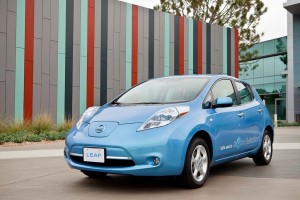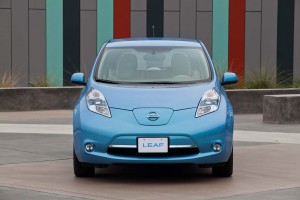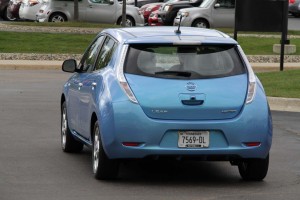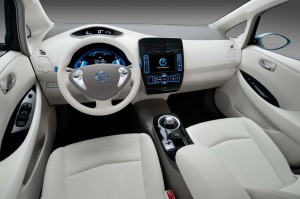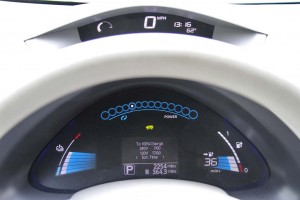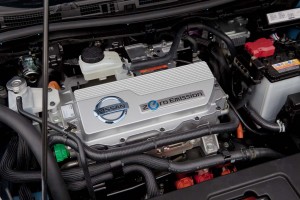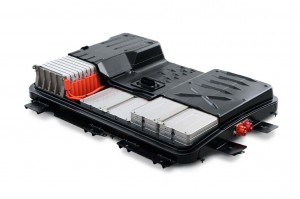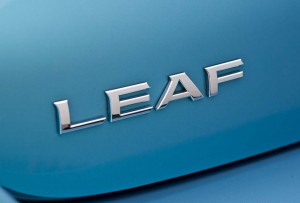Automakers, by nature, tend to be a risk-averse group. No surprise considering a major new vehicle program can quickly run costs up to a billion dollars or more.
Yet, Nissan is putting plenty on the line as it gets ready to roll out its first battery-electric vehicle, or BEV, the 2011 Leaf. Not just money, but prestige, with CEO Carlos Ghosn’s own reputation on the line as he personally champions the breakthrough battery car.
Will the 2011 Nissan Leaf live up to expectations as the first purely battery-driven automobile to meet the needs of the typical American motorist, rather than tech-crazy “first adopters” and enviro-addicts willing to opt for anything promoted as green? To find out, we jumped at the change to drive the new BEV, which Nissan had waiting for us at its technical center in suburban Detroit.
It takes only a quick glimpse to recognize the Leaf isn’t your everyday automobile. Like Toyota, with the popular Prius, Nissan has opted for a unique – and distinctive – design that will blare out, “I’m different,” as it rolls by.
Now, that’s not just to let owners easily show off their environmentalist bona fides. There’s a practical purpose to the sweeping lines of the 2011 Nissan Leaf. Minimizing aerodynamic resistance has yielded a significant bump in the BEV’s range and improved performance as well, the maker claims. It also has advantages when it comes to creature comfort.
In the plus column when it comes to electric vehicles is their naturally quiet nature. You don’t have a big internal combustion engine roaring away directly in front of you. But that creates what some call the “stumps in the swap syndrome.” All the little tics and pops that are normally masked by the IC engine are suddenly quite apparent.
So, Nissan has had to take a lot of steps to mask or reduce those noises. It came up with an all-new design for the radio antenna, for example, and the odd, bulging headlights on the Leaf actually help direct airflow away from the mirrors, reducing wind noise.
There’s been a fair bit of confusion and misinformation in the media about Leaf, compounded by the maker’s decision to let a number of autowriters drive an early “mule” that borrowed the body of a Nissan Versa.
The two vehicles are roughly the same size, overall, explains Leaf product planner Mark Perry, but the battery car is built off an entirely unique platform designed to better accommodate the electric drivetrain. There’s a lot of mass and weight, for one thing, that you want to keep as low and central as possible to enhance vehicle stability and even improve the platform’s overall rigidity.
Leaf is ever so slightly larger than the Versa and, as we realized slipping inside the 5-seater, makes better use of its interior space. Like the Prius, the subcompact exterior conceals a nearly midsize cabin.
The vehicle we got to drive, this week, was a pre-production model, so there were plenty of places Perry stressed, that will need to be revised or improved by the time the first 2011 Nissan Leaf reaches showrooms, later this year. Fit-and-finish wasn’t quite production-ready, nor was the graining of plastic interior panels. Setting that aside, the cabin is reasonably attractive, though perhaps a little sparse for a vehicle that carries a $32,000 sticker – more on that shortly.
There’s a distinctly high-tech feel, with several different digital displays, including a small navigation screen atop the center stack, and others visible both between and looking over the steering wheel.
Beyond the basic navigational duties, the bigger screen can be configured to show where you can drive without recharging – and to show where the nearest public charging stations are located. The various LCD displays take on numerous other duties, including letting you know you’re maximizing your energy efficiency. Indeed, as you learn to avoid jarring hot-foot starts, a little digital pine tree will appear to grow alongside the speedometer.
As I slipped behind the wheel, Perry advised me to tap a few buttons to the left of the wheel. That way, when I turned the key, the Leaf gave me an audible confirmation it was coming to life. Kudos to Nissan for this feature. Even long-time Prius owners complain about the lack of a buzz, beep or engine roar to confirm “ignition.”
Slipping into gear, I rolled backwards out of my parking spot, a very subtle chime sounding to alert pedestrians. It’s not the most charming sound, but at least it isn’t the grating beeeep of a garbage truck. Nissan engineers also “wanted to get out ahead” on another issue of concern, noted spokesman Brian Brockman.
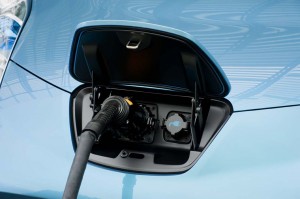
Motorists will almost certainly want the faster 220V charger rather than relying on slow 110V power.
As I earlier noted, these vehicles are phenomenally quiet, a particular concern to the blind who must rely on auditory cues when crossing streets. At speeds up to 18 mph, the 2011 Nissan Leaf produces an artificial engine noise – though you can shut that off, if you wish, but it’s all but inaudible in the well-insulated interior.
Shifting into Drive, I quickly discovered one of the unexpected delights of electric propulsion: instant, wheel-spinning torque. Leaf’s single electric motor produces a seemingly so-so 80 kilowatts of power, or 107 horsepower. But it also yields 280 Newton-meters of torque, which translates into an aggressive 207 lb-ft. And that torque peaks the moment the motor starts spinning, in stark contrast to an internal combustion engine.
Ghosn himself claims 0 to 60 times of “less than 10 seconds,” something we’ll wait for the final production model to confirm. But launch feel is more impressive than that would suggest. As with other battery cars, Leaf’s controlling software has been programmed to give you a quick punch from 0 to around 35 mph, then taper off. Top speed is rated at 90 mph, though once you’ve hit 70 don’t expect to get there in a hurry.
Our driving loop gave us a bit of time on the highway, where Leaf was a lot more comfortable than some other small battery vehicles – like the Think City – we’ve driven. But don’t expect to be spending a lot of time in the left lane.
Of course, you wouldn’t want to if range matters. Nissan expects to deliver about 100 miles on a full charge, but that figure is followed by a big asterisk. A chart we were shown underscores that battery cars are even more sensitive to driving conditions than a gasoline vehicle.
Slog it out in city traffic on a cold day with the heat blasting and you could see range slip to 62 miles. Other than jack-rabbit starts, nothing will cut into range as much as using Leaf’s electric heater. On a comfy day, with traffic moving along at a leisurely pace and the climate control shut off, Nissan engineers have clocked as much as 138 miles.
As with a regular hybrid, Leaf uses regenerative braking to recapture energy normally lost during braking and coasting, which can yield significant additional range. You can shift to Eco mode to enhance Regen – and also to take several other range-enhancing measures, such as reducing the responsiveness of the throttle pedal.
And when you need a charge? The car comes with a cord to let you plug into a standard 110-volt outlet. But don’t expect to go anywhere soon. If you’ve completely drained the 24 kWh prismatic Lithium-Ion battery pack you’ll wait about 20 hours. However, if you have access to a 220V line, that drops to as little as 7 hours. And Nissan is working with a variety of state and local governments, as well as utilities and other partners, to put in place 440V chargers that can top off the battery to 80% of capacity in as little as 30 minutes.

The 2011 Nissan Leaf carries a $32,780 sticker, but after various federal and state credits that can drop to $25,000 or less.
The maker has partnered with Aerovironment to install home 220V charger packs. Prices will vary, of course, but Perry says the average installation will cost about $2,000. And a federal tax credit will cover up to half. That’s on top of the $7,500 federal tax credit that could reduce the price of a Leaf from $32,780 to a more manageable $25,280. (A number of states, like California, kick in as much as $5,000 cash of their own.)
Research shows that the vast majority of American motorists put on less than 100 miles a day, in fact, 70% usually run up less than 40 miles, the target for battery range of the soon-to-launch Chevrolet Volt. While the two makers contend they are not trying to bash one another, they reveal very different strategies.
Nissan contends most folks simply don’t need more than 100 miles range, and if they do they’re likely to have a second vehicle at home. The more complex and costly gas/electric Volt drivetrain is aimed at overcoming so-called “range anxiety,” so one car will fit mostly all possible needs.
Which – if either – will do a better job connecting with potential American buyers remains to be seen. Certainly, a big jump in gasoline prices would enhance their appeal. But even at $3 a gallon, you’re looking at less than 3 cents a mile for energy, (at a utility rate of $0.11 a kWh), compared with 12 cents for a similarly-sized gasoline vehicle.
Considering that the overall feel behind the wheel is about what you’d expect of a typical subcompact sedan, the driving experience is pretty much comparable to that of a Versa or even a base Sentra. The decision process will likely weigh factors like energy costs and environmental friendliness, a hard-to-define factor that still carries a lot of weight for many folks.
For its part, Nissan and French partner Renault plan to have global capacity to produce 550,000 battery vehicles – of which Leaf will be just one – by 2013, which would put the underlying platform in the global mainstream. That’s a risky bet. But considering the ever-increasing push for clean, fuel-efficient transportation, Nissan is counting on first-mover advantage.
And from our first drive, the 2011 Nissan Leaf moves quite nicely. But will U.S. drivers be willing to live with its limitations? We’ll get a better sense of that by late next year.

